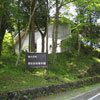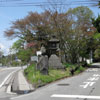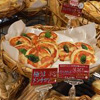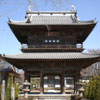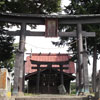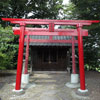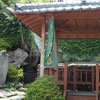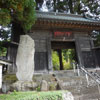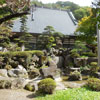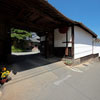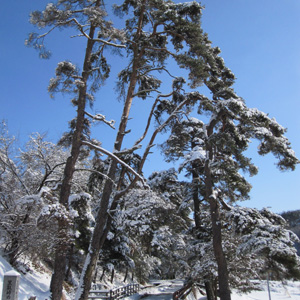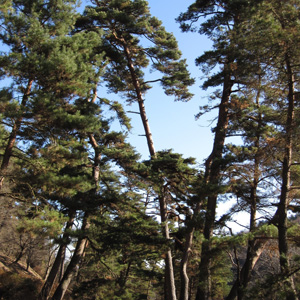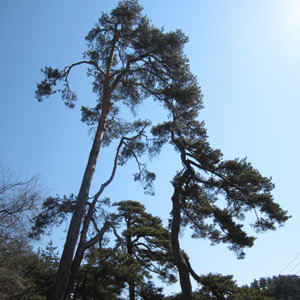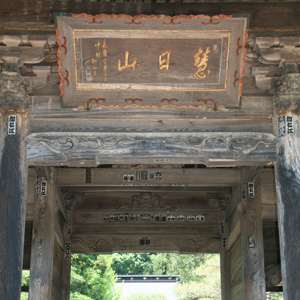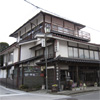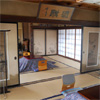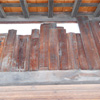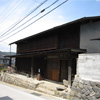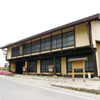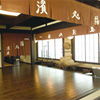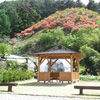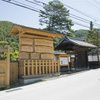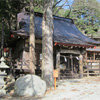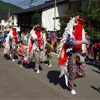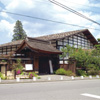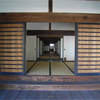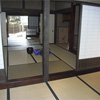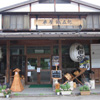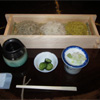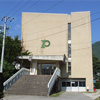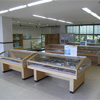- Usui Touge Miharashi-dai (Usui Pass Lookout Platform)It is on the prefectural boundary of Gunma and Nagano Prefectures and…
-
Usui Touge Miharashi-dai (Usui Pass Lookout Platform)
It is on the prefectural border of Gunma and Nagano Prefectures and has views of the three mountains in Gunma Prefecture (Mt. Akagi, Mt. Haruna and Mt. Myogi), Nikko Mountain ranges, magnificent Mt. Asama and Yatsugatake mountains. The autumn foliage spreading all the way to the base of the mountains can also be sen here.
- Important cultural property: Former Mikasa HotelThis Western style wooden hotel was designed and constructed…
-
Important cultural property: Former Mikasa Hotel
This Western style wooden hotel was designed and constructed by Japanese in the late Meiji period. It still preserves the atmosphere of the time when many celebrities visited during the Meiji and Taisho periods. It was designated as a national important cultural property in May 1959.
- Karuizawa Shaw Memorial ChurchMissionary A.C. Shaw who made Karuizawa famous as a summer resort…
-
Karuizawa Shaw Memorial Church
Missionary A.C. Shaw, who made Karuizawa famous as a summer resort, was at this oldest church in Karuizawa.
- [Train] 15 minutes by taxi from [Karuizawa Station] on the Hokuriku Shinkansen/Shinano Railway
- [Car] 35 minutes from [Usui-Karuizawa Interchange] on the Joshin-etsu Expressway
- [Nearest bus stop] [Kyu Karuizawa] bus stop of the Karuizawa Chonai Junkan Bus (Higashi/Minami-mawari sen): Karuizawa town Loop Bus (Eastern/Southern route line)
- Folk Heritage MuseumThis facility stores earthenware made in the Jomon period…
-
Folk Heritage Museum
This facility stores earthenware made in the Jomon period, materials concerning the cultural history of roads, including the history of post towns of the Tosando and the Nakasendo, materials introducing development as an area of villas in the Meiji period and later, and materials including tools that supported life in cold and high altitude regions and is open to the public.
- Annex of Archives Hall, Ichimura Memorial HallThe building of the Memorial Hall was built by the Western…
-
Annex of Archives Hall, Ichimura Memorial Hall
The Memorial Hall was built by the Western-style house building company America-ya in the Taisho period; Nozawa Genjiro purchased the building from Konoe Fumimaro in 1926. In 1932, Ichimura Kesazo, who was a political scientist and had friendly relations with Konoe, bought the building; it was relocated and reconstructed in Minamihara the next year. After that, the building was restored and reconstructed in the current location at the east end of Amamiya Pond in 1997 and was donated to the town by the Ichimura family. Many materials of Ichimura Kesazo, who contributed to development of Minamihara as an area of villas, and his wife Ichimura Kiyoji, who became an honorary townsperson, are displayed here, as well as materials concerning Amemiya Keijiro and Konoe Fumimaro. Ichimura Memorial Hall was designated as a cultural property of Karuizawa Town (Designation No. 19) on May 24, 2016.
- Regional exchange facility, Kutsukake TerraceThe regional exchange facility was built in front of Naka-karuizawa Station…
-
Regional exchange facility, Kutsukake Terrace
The regional exchange facility was built in front of Naka-karuizawa Station on the Shinano Railway by the town and opened on April 1, 2013. The regional exchange facility is Kutsukake Terrace, named after the former name of the area. Kutsukake was the name of one of the post towns on the former Nakasendo just like Karuizawa. Here you will find the Tourist Information Center, a library and "challenge shops", witch are used by entrepreneurs who wish to open shops in the area.
- [Train] 20 minutes on foot from [Naka-karuizawa Station] on the Shinano Railway
- [Car] 25 minutes from [Usui-Karuizawa Interchange] on the Joshin-etsu Expressway
- [Nearest bus stop] [Toshokan Mae] bus stop of the Karuizawa Chonai Junkan Bus (Higashi/Minami-mawari sen): Karuizawa Town Loop Bus (Eastern/Southern route line)
- Oiwake-juku Local MuseumThis museum mainly exhibits and introduces materials about…
-
Oiwake-juku Local Museum
This museum mainly exhibits and introduces materials about Oiwake-juku a prosperous station in the Edo period located at the junction point of the Nakasendo and the Hokkoku Kaido . You can hear a traditional folk song called Oiwake-bushi that was passed down here and spread all over Japan.
- Hori Tatsuo Memorial Museum of LiteratureThis Museum of Literature exhibits and introduces materials…
-
Hori Tatsuo Memorial Museum of Literature
This Museum of Literature exhibits and introduces materials concerning Hori Tatsuo who is well known as the author of Kaze Tachinu (The Wind Has Risen) and Utsukushii Mura (Beautiful Village) and loved Karuizawa. On the premises are the residential house, where he spent his later years and eventually passed away, exhibition building, Hori Tatsuo literature monument and administrative building.
- WakasareIt was a junction of the Nakasendo and the Hokkoku Kaido…
-
Wakasare
It was a junction of the Nakasendo and the Hokkoku Kaido during the Edo period. Turning to the left is the Nakasendo towards Kyoto and turning to the right is the Hokkoku Kaido towards Niigata. Seven stone works made in the Edo period still exist: a signpost built in 1679, an all-night light, the Shinratei Bansho monument engraved with his comic tanka, a Kosodate (child-raising) Jizo statue, a Seishi Bosatsu (guardian deity of year of the horse) statue, a Batou Kannon statue and a Kaikoku (pilgrimage) tower.
- [Train] 30 minutes on foot from [Shinano Oiwake Station] on the Shinano Railway
- [Car] 25 minutes from [Usui-Karuizawa Interchange], 20 minutes from [Saku Interchange] on the Joshin-etsu Expressway
- [Nearest bus stop] [Oiwake Shojin Bashi] bus stop or [Oiwake Kominkan] stop of the Karuizawa Chonai Junkan Bus (Nishi Course): Karuizawa town Loop Bus (Western Course)
- Houjuin TempleThe Houjuin is a title but the actual detailed title is Nyoihouju…
-
Houjuin Temple
The Houjuin is a title but the actual detailed title is Nyoihouju. Ju used in both the titles means a precious stone that generates all sorts of treasures as you pray and also saves you from pain and sickness. Ju symbolizes the infinite blessings of the Buddha and the Buddhist Scriptures. The temple name originated from the expression of the Buddha's oath that eliminates the sins of people and fulfills their prayers.
- Bestowed dollIn 1861, Princess Kazu descended along the Nakasendo and stopped…
-
Bestowed doll
In 1861, Princess Kazu traveled along the Nakasendo and stopped at Otai-juku on her way to her marriage to the Shogunate family for reconciliation between the Imperial Court and the Shogunate. At that time, a boy waiter received a doll from Princess Kazu as a reward; the doll is still well preserved today. (Closed to the public.)
- Nagakura Suwa ShrineThe shrine forest is a natural treasure designated by the town.…
-
Nagakura Suwa Shrine
The shrine forest is a natural treasure designated by the town. At the side of the main shrine building are straw horses used for the Dosojin festival that is held from late January to early February every year.
- Bakery Café Kokorade Otai-jukuBakery Café Kokorade is located near the Nakasendo.…
-
Bakery Café Kokorade Otai-juku
Bakery Café Kokorade is located near the Nakasendo. From the terrace, a vast lettuce field and a panoramic view of Mt. Asama can be seen. The popular products are Danish bread baked with rich butter and salt bread. You can buy and enjoy bread with free coffee at the spacious cafeteria. Feel free to come and shop with children since there is a kid’s space in the shop. Please try Kokoradean inspired by the Nakasendo.
Hours: 8:00 - 18:00 (Opening hours may change depending on the season.)
458-2, Oaza Maseguchi, Miyota-cho, Kitasaku County, Nagano
0267-41-0383 - Otai-juku FestivalOtai-juku Festival held on August 16 every year. …
-
Otai-juku Festival
The Otai-juku Festival is held on August 16 every year.
Princess Kazu is said to have stopped at the Otai-juku Honjin on her way to her marriage to Tokugawa Iemochi and gave a boy waiter a doll in the shape of a child.
The festival reproduces this scene with a girl who plays Princess Kazu and the bestowed doll in a sedan chair litter carried by attendants; processions of people wearing clothes reminiscent of those days walk together inside the post town premises. In addition to the procession of Princess Kazu, events such as a bazaar and catching fish by hand will be held on the festival day.Date: August 16 every year
Hours: From noon to 6 in the evening every year, the procession of Princess Kazu starts at 1 p.m. and events including a bazaar and catching fish by hand start from 6 p.m.Miyota Town, Industry and Economy Division, Commerce, Industry and Tourism Department, 0267-32-3111
- [Train] Walk from [Miyota Station] on the Shinano Railway
- [Car] 10 minutes from [Saku Interchange] on the Joshin-etsu Expressway
- [Nearest bus stop] Otai-kamijuku bus stop on the Saku Miyota Line of Chikuma Bus
- Ryuun-ji TempleTakeda Shingen was a devoted believer of this temple…
- Sainen-ji TempleThis temple was the family temple of Sengoku Hidehisa who was…
-
Sainen-ji Temple
This temple was the family temple of Sengoku Hidehisa, who was a lord of Komoro Domain, and of Naito Masakuni, who was a lord of Iwamurada Domain. The moss-covered five-ring pagoda has a historical atmosphere over 400 years old. The grave and poem monument of Yoshizawa Takaaki, who was a Japanese classical scholar in the mid Edo period, are here. The seated statue of Amida Nyorai (Amitabha Tathagata) as the principal image of this temple is designated as a prefectural treasure.
- KotesannePeople including the elderly and local residents can gather at ease.…
-
Kotesanne
People including the elderly and local residents can gather at ease. The traditional culture of Iwamurada-juku on the Nakasendo is handed down here. It opened as a challenge shop in 2014 for young entrepreneurs operating eating and drinking businesses to showcase their skills. An artwork called, "Kisodochu Iwamurada", which is the 23rd picture of the 69 post towns of the Nakasendo drawn by Keisai Eisen, is used as their symbol.
- [Train] 5 minutes on foot from [Iwamurada Station] on the JR Koumi Line
- [Car] 5 minutes from [Saku Interchange] on the Joshin-etsu Expressway
- [Nearest bus stop] [Iwamurada] bus stop of Chikuma Bus (Nakasendo Line)
- Shionada ShrineThis shrine was built to protect Shionada-juku and later…
-
Shionada Shrine
This shrine was built to protect Shionada-juku and later renamed Hiesha Shrine. Due to the shrine merger in 1908, the shrine was renamed Shionada Shrine after merging with Taki Daimyojin Shrine, Akibasha Shrine, Shaguchisha Shrine and Tenjinsha Shrine. The enshrined deities are Oyamakui no Mikoto, Kagayamato no Mikoto, Hayamado no Mikoto, Tsukiyomi no Mikoto, Sugawara no Michizane and Sarutahiko no Mikoto. Makino Yasunaga is also worshiped.
- Madara Inari ShrineIt is on the precincts of Kotakuzan Shinnyuin Shoen-ji Temple that…
-
Madara Inari Shrine
It is on the precincts of Kotakuzan Shinnyuin Shoen-ji Temple that is a branch temple of Chionin Temple of the Jodo sect and transferred and enshrined the Senior First Rank Inari Daimyojin in 1787. It was greatly worshiped when sericulture was a thriving business. Currently, it is famous since it is said that you’ll find what you lost if you offer abura-age, which is a piece of deep-fried tofu.
- OtakiOriginally, this waterfall was on the precincts of Taki Daimyojin…
-
Otaki
Originally, this waterfall was on the precincts of Taki Daimyojin Shrine and a great amount of spring water from the base of the big keyaki tree relieved the thirst of travelers who came and went on the Nakasendo. The amount of spring water decreased and it became unavailable for drinking water, but an arbor was built there and used as a resting place. The hall of Fudoson (Acala) enshrined near Otaki was moved to the new hall above the waterfall.
- [Train] 15 minutes by car from [Sakudaira Station] on the Hokuriku Shinkansen/JR Koumi Line
- [Car] 20 minutes from [Saku Interchange] on the Joshin-etsu Expressway
- [Nearest bus stop] [Shionada] bus stop of Chikuma Bus (Nakasendo Line)
- Kourasha ShrineIt is the old main shrine on the precincts of Hachiman Shrine.…
-
Kourasha Shrine
It is the old main shrine on the precincts of Hachiman Shrine. The main shrine was newly built in 1783, which is when the old main shrine was moved to the current location. Both the building and the wooden tag commemorating the foundation of the temple are designated as important national cultural properties. This shrine is thought to have originally been Koma Shrine that deifies the Migrant Origins of the Koma clan who settled around here and started cattle breeding. The shrine was rebuilt by Shigeno (Toutoumi no kami) Mitsushige who was the lord of Mochizuki Castle in 1491.
- Hachiman Shrine On the precincts are the main shrine, worship hall, Kourasha,…
-
Hachiman Shrine
On the precincts are the main shrine, worship hall, Kourasha, Mizugakimon gate and Zuijinmon gate. In the Gakuden (building to store votive tablets) is the Sangaku (votive tablet with a math puzzle) offered in 1780 that is considered the oldest Sangaku in the prefecture. Since there are descriptions relating to Japanese mathematics on the Sangaku, it is a precious historical material that swows mathematics in the Edo period.
- [Train] 15 minutes by car from [Sakudaira Station] on the Hokuriku Shinkansen/JR Koumi Line
- [Car] 15 minutes from [Saku Interchange] on the Joshin-etsu Expressway
- [Nearest bus stop] [Hachiman Jinja Mae] bus stop of Chikuma Bus (Nakasendo Line)
- Stone Buddha statues in NagasakaStatues of Sekison Daigongen, Myodorikitokunogyoja, Shinsei Reijin,…
-
Stone Buddha statues in Nagasaka
Statues of Sekison Daigongen, Myodorikitokunogyoja, Shinsei Reijin, Naganoshin Reijin, Shinmei Reijin, Daisyo Fudo, Fukan Reijin, Mokujiki Isshin Reijin, Ontakesan Zao Daigongen, Mikasayama Touri, Bato Kannon, Bato Daishi, Suijinten, Hyakumanben Kuyo-to, Dosojin and many stone monuments relating to Shugendo, which is Japanese mountain asceticism syncretizing Shinto and Buddhist beliefs and concepts, are here.
- Otomo ShrineOne of the three shrines in Saku: Eta Shrine, Nagakura Shrine,…
-
Otomo Shrine
One of the three shrines in Saku: Eta Shrine, Nagakura Shrine, Otomo Shrine. The Sakaki Matsuri is an annual festival of the Otomo Shrine that is held on the temple precincts every year.
- Jokoin TempleMochizukiyama Jokoin Temple is a branch temple of the Seiko-ji Temple…
-
Jokoin Temple
Mochizukiyama Jokoin Temple is a branch temple of the Seiko-ji Temple of the Soto sect in Nagasaka Town of the Kita Koma district, Kai Province (current Hokuto City, Yamanashi Prefecture) and was the family temple of the Mochizuki clan for generations. The temple precincts are believed to have been the site of their residence.
- [Train] 20 minutes by car from [Sakudaira Station] on the Hokuriku Shinkansen/JR Koumi Line
- [Car] 20 minutes from [Saku Interchange] on the Joshin-etsu Expressway
- [Nearest bus stop] [Mochizuki Terminal] bus stop of Chikuma Bus (Nakasendo Line)
- Takeshige Honke Brewing Corp.The residential house built in the late Edo period and the sake…
- Osawa Sake Brewery Co., LtdStarted sake brewing from 1689 in Motai, which…
-
Osawa Sake Brewery Co., Ltd
The company started sake brewing from 1689 in Motai, which has Mt. Tateshina’s subsoil water and a natural environment suitable for rich local rice and sake brewing. The Museum of History and Folklore exhibits materials relating to sake brewing and cultures developed together with the Nakasendo.
- Wakayama Bokusui poem monumentBokusui is well-known for loving sake. In Mochizuki, the traces of his…
- [Train] 30 minutes by car from [Sakudaira Station] on the Hokuriku Shinkansen/JR Koumi Line
- [Car] 30 minutes from [Saku Interchange] on the Joshin-etsu Expressway
- [Nearest bus stop] [Motai Iriguchi] bus stop of the Chikuma Bus (Nakasendo Line)
- Tateshina Town Furusato Exchange Center: Ashita-shukuThe Furusato Exchange Center promotes cultural activities of…
-
Tateshina Town Furusato Exchange Center: Ashita-shuku
The Furusato Exchange Center promotes cultural activities of local residents and contributes to enhancing cultural education. This facility is also used as a gallery for private exhibitions and group presentations. Please feel free to use this facility as a resting place when visiting Ashita-shuku on the Nakasendo.
Hours 9:00 - 21:30
Closed December 29 - January 3Tateshinamachi Town Office, Social Education Department, Social Education Human Rights Policy Section
Phone: 0267-56-2311/Extension 252 - Lined pine trees at Kasatori PassLined pine trees still stand along the road for approximately…
-
Lined pine trees at Kasatori Pass
Lined pine trees still stand along the road for approximately 2 km from a point 1 km to the west of Ashita-shuku to Kasatori Pass. The view of 150 - 300 year old Japanese umbrella pine trees is magnificent. They were planted circa 1604 and a record remains that says supplemental planting was done in 1845. The subsequent investigation found that 229 trees still existed in 1924 and 127 existed in 1974, when they were designated as a natural treasure of Nagano Prefecture; 64 trees existed as of April 2014.
- Tsugane-ji TempleThe official name of this temple is Enichizan Shugakuin Tsugane-ji…
-
Tsugane-ji Temple
The official name of this temple is Enichizan Shugakuin Tsugane-ji Temple and this temple was listed as one of the five famous Shinano Tendai sect temples in the Edo period. This temple belongs to the Tendai sect and is said to have been founded by the monk Gyoki in AD 702. After that, the monks Saicho and Ennin established the Tendai Dangisho as a temple to educate scholar monks. Since then, the temple has been a local place of academic learning in the Shinano region and a bearer of cultural and academic exchange with the Kyoto, Kanto and Tokai regions, continuing to the present day.
- [Train] 30 minutes by car from [Sakudaira Station] on the Hokuriku Shinkansen/JR Koumi Line
- [Car] 30 minutes from [Saku Interchange] on the Joshin-etsu Expressway
- [Nearest bus stop] [Ashita] bus stop of Chikuma Bus (Nakasendo Line)
- Ippukudokoro Hama-yaThe building is a large two-story building characterized by…
-
Ippukudokoro Hama-ya
A large two-story building characterized by the dashigeta-zukuri structure. It is open to the public as a resting place for visitors and also as an exhibition place of materials relating to post towns.
- Nagakubo-juku Honjin <Ishiai family residential building>This place was used as a honjin and ton-ya through the Edo period.…
-
Nagakubo-juku Honjin <Ishiai family residential building>
This place was used as a honjin and ton-ya through the Edo period. The eldest daughter of Sanada Nobushige (Yukimura) lived here after her marriage with the fourth head of the family who ran this honjin. The main hall, used for honored guests including daimyos, and the front gate (Yakuimon), constructed at the end of the Edo period, still exist. The main hall is thought to have been built in the late 17th century and is the oldest remaining honjin on the Nakasendo. (Since this is private property, it is closed to the public.)
- Kamanari-ya (Takeuchi family residential building)From the mid 17th century, the Kamanari-ya was a sake and soy sauce…
-
Kamanari-ya (Takeuchi family residential building)
From the mid 17th century, the Kamanari-ya was a sake and soy sauce brewery and also used as a post town. The main building has an eye-catching wing wall integrated with an independent small roof called hon-udatsu and the overwhelming open space from the floor to the ceiling inside the building shows thick pillars and dynamic beam assembly. The building is thought to have been built before 1731 and is believed to be the oldest merchant house in the prefecture. (Since this is private property, it is closed to the public.)
- Hamadaya Ryokan InnThis is the only inn still in business at Nagakubo-juku.…
-
Hamadaya Ryokan Inn
This is the only inn still in business at Nagakubo-juku. Nagakubo-juku is an L-shaped post town located at a point where Tate-machi Town and Yoko-machi Town intersect. The building of Hamadaya Inn is a wooden three-story hatago style building that is very rare as a building in post towns. Spending a comfortable time and taking your mind off everyday life at this inn is refreshing. Offers delicious and home‐made dishes. (Carp dishes are also available but reservations are required.)
~Room~
10 Japanese style rooms
~Lodging charges~
One night with two meals: 7,800 yen; One night with breakfast: 6,000 yen; One night without meals: 5,000 yenPhone: 0268-68-2109
Fax: 0268-68-2109 - Kamanari-ya (Takeuchi family)From the mid 17th century (early Edo period), the Kamanari-ya was a…
-
Kamanari-ya (Takeuchi family)
From the mid 17th century (early Edo period), the Kamanari-ya was a sake and soy sauce brewery and also used as a post town. The main building has an eye-catching wing wall integrated with a small independent roof called hon-udatsu and the overwhelming open space and construction inside the building shows thick pillars and dynamic beam assembly. Although the exact period of the construction is unknown, it is thought to have been built before 1731 and is believed the oldest merchant house in the prefecture since there was no trace of replacing the talisman made in 1731. (Since this is private property and being used as a residence, it is closed to the public.)
Nagawa Town, Wada Branch Office of Education Board, Cultural Property Section
Phone: 0268-41-6123 - GoichianIt is located at the Edo side of Nagakubo-juku and the building…
-
Goichian
It is located at the Edo side of Nagakubo-juku and the building was probably built between the late Edo and early Meiji periods. Horses were thought to also have been reared here in addition to crop cultivation. The layout of a farming house in the old days can be seen on the first floor; tools used for sericulture and materials about the history of the post town are exhibited on the second floor.
Admission fee: Free
Phone: 0268-68-3023
- Nagakubo-juku Museum of History Ippuku-dokoro Hama-ya Nagakubo-jukuThe building was built as an inn in the early Meiji period but failed…
-
Nagakubo-juku Museum of History Ippuku-dokoro Hama-ya
The building was built as an inn in the early Meiji period but failed to open because of reduced traffic on the Nakasendo due to transportation changes. The building is a large two-story building with a characteristic architectural feature where the second floor overhangs the first floor called dashigeta-zukuri. It is open to the public as a resting place for visitors to Nagakubo-juku and also exhibits historical and ethnological materials relating to post towns.
Hours: 9:00 - 16:00
Admission fee: Free
Closed: Every Monday (or on the following day if it falls on a national holiday) and during the winter from December 1 - March 31Nagawa Town, Wada Branch Office of Education Board, Cultural Property Section
Phone: 0268-41-6123 - Nagakubo-juku Honjin <Ishiai family residential building>This place was used as a honjin and ton-ya through the Edo period.…
-
Nagakubo-juku Honjin <Ishiai family residential building>
This place was used as a honjin and ton-ya through the Edo period. Suhe, who was the eldest daughter of Sanada Nobushige (Yukimura), lived here after her marriage with the fourth head of the family who ran this honjin. The main hall used for honored guests including daimyos and court nobles and the front gate (Yakuimon) constructed at the end of the Edo period still exist. Judging from the tall skirted sliding screen, the transom structure and the design details seen in the shoin-zukuri style, the main hall was probably built in the late 17th century and is the oldest remaining honjin on the Nakasendo. (Since this is private property and used as a residence, it is closed to the public.)
Nagawa Town, Wada Branch Office of Education Board, Cultural Property Section
Phone: 0268-41-6123 - Matsuo Shrine Nagakubo-jukuMatsuo Shrine is located to the east of Nagakubo-juku.…
-
Matsuo Shrine
Matsuo Shrine is located to the east of Nagakubo-juku. The enshrined deity of Matsuo Shrine in Kyoto was divided and enshrined here. This shrine is worshiped by nearby sake breweries as the guardian deity of sake brewing. An annual festival is held every September and the Oyamajishi dance where three lions appear is dedicated to the shrine.
Nagawa Town, Wada Branch Office of Education Board, Cultural Property Section
Phone: 0268-41-6123 - Oyamajishi FestivalAnnual Festival of Matsuo Shrine as the main place to worship the local…
-
Oyamajishi Festival
Annual Festival of Matsuo Shrine as the main place to worship the local shinto deity of Nagakubo. In modern days, Michiyuki, which is the marching of Shishimai (lion dance) all around the post town is held every three years. The dance is performed by dancers dressed as two male lions and one female lion. The Kyoto style musical accompaniment with song, flute and drum is elegant and the dance is said to pass the ancient style on. The lineup of the michiyuki marching to the shrine is osakaki, tengu, ojishi (male lion), haeoi, mejishi (female lion), haeoi, ojishi, haeoi, taiko(drum), taikomochi(taiko supporter), koujougata, hyoushiki(clappers), utaite(singer), hue(flute), saireiyakuin(festival director) and ujikoichido(shrine parishioners) in order and clowns called hyotangata go back and forth to control traffic around the procession.
Event date: First Sunday in September
Nagawa Town, Wada Branch Office of Education Board, Cultural Property Section
Phone: 0268-41-6123 - [Train] Approximately 60 minutes by fixed‐route bus from [Ueda Station] on the JR/Shinano Railway
- [Car] Approximately 40 minutes from [Saku Interchange] on the Joshin-etsu Expressway (via Route 142 toward Kasatori Pass)
- [Nearest bus stop] [Nagakubo] bus stop of the JR bus
- National Historic Site Wada-juku HonjinIn March 1861, the main building, which was the honjin building…
-
National Historic Site Wada-juku Honjin
In March 1861, the main building, which was the honjin building and living space, with a dashigeta-zukuri structure was rebuilt after a great fire for the marriage of Princess Kazu. The chestnut wood roof made by hand and covered in 1633 stones is one of the largest in Japan.
Closed: Every Monday (or on the following day if it falls on a national holiday) and for winter from December 1 - March 31
Hours: 9:00 - 16:00
Admission fee: 300 yen for adults, 150 yen for children
(An admission ticket issued here is a common admission ticket that can be used to enter the Daikoku-ya Resource Center, Kawachiya Historical Road Museum and the Museum of Obsidian Stone Tools.)Wada-juku Honjin
Phone: 0268-88-2348 - Kawachiya Historical Road Museum Kawachiya was a large scale hatago in Wada-juku and is a…
-
Kawachiya Historical Road Museum
Kawachiya was a large scale hatago in Wada-juku and is a representative example of a hatago building with a lattice door and the projecting girder style called dashigeta-zukuri showing the architectural style in the late Edo period. A room with a raised floor is in the inner parlor. Considering that Princess Kazu and her party stayed here on her way to marry into the Shogunate family, this room was built for her.
Closed: Every Monday (or on the following day if it falls on a national holiday) and for winter from December 1 - March 31
Hours: 9:00 - 16:00
Admission fee: 300 yen for adults, 150 yen for children (An admission ticket can be used as a common admission ticket for the Wada-juku Honjin.)Kawachiya Historical Road Museum
Phone: 0268-88-2794 - Komeya TetsugoroThis place was once called Ue no Ton-ya. Currently, it is in business as a rest…
- Furusato Wada-juku Shukuba Matsuri (Post Town Festival)The Wada-juku Shukuba Matsuri is the summer festival of Wada-juku.…
-
Furusato Wada-juku Shukuba Matsuri (Post Town Festival)
The Wada-juku Shukuba Matsuri is the summer festival of Wada-juku. Hanayome Dochu and Jidai Gyoretsu that reproduces the atmosphere of the late Edo period is held on August 14 every year. During the Obon period, lanterns hand-made by local residents decorate the road, producing attractive and fantastic effects by illuminating the post town.
Event date: 17:00 - 21:00, August 14
Venue: Wada-juku Honjin - Wada Elementary SchoolFurusato Wada-juku Shukuba Matsuri (Post Town Festival) Executive Committee, Administration Office
Phone: 0268-88-2345 - Minshuku (Inn) Miya Wada-jukuAt Minshuku Miya, the owner chef with 35 years of experience offers delicious…
-
Minshuku (Inn) Miya
At Minshuku Miya, the owner chef with 35 years of experience offers delicious dishes using homegrown vegetables and rice cooked in an earthenware pot.
★ We help you to overcome the most difficult part of the Nakasendo ★
We help many travelers to pass through Wada Pass every year as the nearest inn to Wada-juku and Wada Pass. We pick you up and drop you off, at the same place the next morning, anywhere on the Nakasendo from Sakudaira to Wada Pass and even to Shimosuwa. We can quickly respond, especially at Wada Pass and Wada-juku. We will immediately go to pick you up.~Room~
10 Japanese style rooms
~Lodging charges~
One night with two meals: 6,000 yen; One night with dinner: 5,500 yen; One night with breakfast: 4,500 yen; One night without meals: 3,500 yenPhone: 0268-68-0302
Email: magu@rose.ocn.ne.jp
URL: http://www.kokuyou.ne.jp/~minsyuku/index.html - Wada Pass (Old pass)The route between Wada-juku and Shimosuwa-juku…
-
Wada Pass (Old pass)
The route between Wada-juku and Shimosuwa-juku is around 22 km long. Furthermore, since Wada Pass has the highest point (around 1600m above sea level) of the Nakasendo - also the highest point among the Gokaido (five major highways) - and many steep slopes, travelers were in distress on snowy, rainy and foggy days. At the peak of the pass are Ontakesan Yohaijo Hi (Mt. Ontake worship location monument), Batou Kannon statues and Sai no Kawara Jizo (Deity of Children in Limbo) statues.
A 20-minute walk on the historical Nakasendo from the parking area of Old Wada Pass Ski Ground along the Venus Line. (Walk closed in winter)
Nagawa Town, Wada Branch Office of Education Board, Cultural Property Section
Phone: 0268-41-6123 - Eitai Jinba Segyosho (Rest place for horses and travelers) Wada-jukuThis rest place was built in 1828 to relieve hardships of travelers and…
-
Eitai Jinba Segyosho (Rest place for horses and travelers)
This rest place was built in 1828 using 50 ryo, half of the interest from the 1000 ryo donated by Kaseya Yohei (a wealthy merchant of Gohuku-cho in Edo). Rice gruel and a blazing fire were provided for travelers crossing the pass from November to March and a small bucket of boiled wheat was served to horses and cows throughout the year.
Free of charge for observation, closed in winter from around December 1 - early April
Nagawa Town, Wada Branch Office of Education Board, Cultural Property Section
Phone: 0268-41-6123 - Wada-juku StationThe Wada-juku Station Specialty Product Direct Sales Shop is located…
-
Wada-juku Station
The Wada-juku Station Specialty Product Direct Sales Shop is located in the Wada district (old Wada village) of Nagawa Town where Wada-juku of the Old Nakasendo was. The Specialty Product Direct Sales Shop, the Local Dishes Area, which is a restaurant run by the Ueko Shinrin Union, vending machines, bathroom and a large parking area are located here. The Direct Sales Shop supports revitalizing attractive local areas as places to communicate and interact between urban areas and rural areas by collaborating with local tourism including direct sales offering local specialty products such as fresh agricultural products, edible wild plants and mushrooms directly from producers. Especially, agricultural products produced in the rich soil of the vast, cold and high-altitude land spreading over the Shinshu region, which is 700m - 1200m above sea level, are soft, delicious and much tastier thanks to their freshness just after harvesting. In addition, edible wild plants of the spring season and mushrooms of the autumn season will be in stores as blessings of nature.
Hours: 8:00 - 17:00 (In winter: 8:30 - 16:30)
Phone: 0268-88-0008
- Soba-ya Tokuda Wada-jukuSoba-ya Tokuda is located at Wada-juku on the Nakasendo and offers…
-
Soba-ya Tokuda
Soba-ya Tokuda, located in Wada-juku on the Nakasendo, aims to show people the true deliciousness of soba and offers hand-made soba from 100% buckwheat flour. The appearance and interior utilizing the historical building named Hatano without any changes will help you to time slip into the Edo period while offering you a comfortable time with delicious dishes.
Hours: 11:00 - 15:00
Closed days: Only irregular holidays (Please contact us by phone before visiting)Phone: 0268-88-2160
- Museum of Obsidian Stone Tools/Forestry Resource Center Wada-jukuWada Pass is known as where the most obsidian is in mainland Japan.…
-
Museum of Obsidian Stone Tools/Forestry Resource Center
Wada Pass is known as the most obsidian-rich area in mainland Japan. At the Omegura ruin located just below Wada Pass, excavations have been conducted for research from long ago and it was found that the ruin is one of the largest scale sites where stone tools were manufactured in the Paleolithic Stone Age even at the nationwide level. In the museum, the manufacturing process of obsidian stone tools is clearly explained using excavated items with obsidian stones from all over Japan. On the fourth floor, the joint exhibition space with the Forestry Resource Center is provided; tools used by mountain workers and stuffed specimens of animals found in mountains and forests of this area are exhibited.
Closed: Every Monday (or on the following day if it falls on a national holiday), and for winter from December 1 - March 31
Hours: 9:00 - 16:00
Admission fee: 300 yen for adults, 150 yen for children (An admission ticket can be used as a common admission ticket for the Wada-juku Honjin.)Kawachiya Historical Road Museum
Phone: 0268-88-2794 - Daikokuya Wada-jukuThis hatago inn was rebuilt after a great fire in 1861. The rebuilt…
-
Daikokuya
This hatago inn was rebuilt after a great fire in 1861. The rebuilt large scale building with the dashigeta-zukuri structure has a frontage of approximately 11 meters and a depth of approximately 13 meters and stands next to a ton-ya. The building was moved to the far side from the street when the road was dug in the Meiji period.
Closed: Mondays (or on the following day if it falls on a national holiday) and in winter from December 1 - March 31
Hours: 9:00 - 16:00
Admission fee: 300 yen for adults, 150 yen for children (An admission ticket can be used as a common admission ticket for the Wada-juku Honjin.)Kawachiya Historical Road Museum
Phone: 0268-88-2794 - [Train] Approximately 70 minutes by fixed‐route bus from [Ueda Station] on the JR/Shinano Railway
- [Car] Approximately 50 minutes from [Saku Interchange] on the Joshin-etsu Expressway (via Route 142 toward Kasatori Pass)
- [Nearest bus stop] [Kamiwada] bus stop of JR bus
| Event name | Event date |
| Shinano Oiwake Magouta Dochu | Fourth Sunday in July |
| Event name | Event date |
| Otai-juku Festival | August 16 every year |
| Event name | Event date |
| Iwamurada Gion Festival | Mid July |
| Hanazura Inari Shrine Hatsuuma-sai (First Horse Day Festival) | February 11 |
| Event name | Event date |
| Shionada-juku Shukuba Matsuri (Shionada-juku Festival) | Second Sunday in October |
| Asashina Dondon Matsuri (Asashina Dondon Festival)/Noryo Hanabi Taikai (Summer Night Fireworks Festival) | August 14 |
| Event name | Event date |
| Sakaki Matsuri known as an eccentric Shinshu festival | August 15 |
| Kusa Keiba Taikai (Local horse race) at Mochizuki Koma no Sato (Village of Horses) | November 3 |
| Event name | Event date |
| Nakasendo Walking in Tateshina | October 18 |
| Event name | Event date |
| Matsuo Shrine Autumn Festival (Oyamajishi Festival) | Early September |
| Tenjinyama Tsutsuji Matsuri (Azalea Festival) | Mid May |
| Event name | Event date |
| Furusato Wada-juku Shukuba Matsuri (Post Town Festival) | August 14 |
| Nakasendo Wada-juku Shin Soba Matsuri (New Buckwheat Crop Festival) | Late November |




